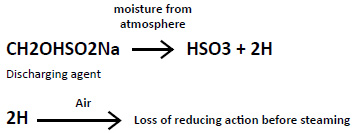Information for this Appendix is provided by Dr R B Chavan
Chemical reactions during discharge printing
The chemical reactions occurring during steaming for white and color discharge printing are
- Destruction of the ground shade obtained during dyeing by reducing property of discharging agent used in the print paste. This would produce white discharge print.
- Fixation of the dye incorporated in the discharge paste to get color discharge effect. Vat dye class meets this requirement. Therefore, invariably vat dyes are commonly used for getting color discharge effects. However, selected dyes belonging to other dye classes which are stable to reducing conditions can also be used provided the selected dyes have affinity to the fabric to be printed. Pigments stable to discharging agent can also be used in discharge paste along with binder to get color discharge effect.
This can be represented by taking typical dye structure:

Typical dye structure which can be discharged
The dischargeable dye can be schematically represented as ARN=NAR the chemical reaction takes place at N=N group which is known as azo group. This group is sensitive to reducing agent.
During steaming and under alkaline conditions the reducing agent undergoes decomposition with the liberation of Hydrogen which acts as reducing agent for decoloration of dye. The reactions are shown as below:
Decomposition of reducing agent
CH2OHSO2Na Sodium sulphoxylate formaldehyde (Rogalit C) BASF
(CH2HSO2)2Zn Zinc sulphoxylate formaldehyde (Decrolin) B&E International

The liberated H obtained by the decomposition of discharging agent during steam causes the decomposition of dischargeable dye into colorless water soluble products which are removed during washing after printing; producing white print effect on dyed fabric. The reaction is shown below

Self decomposition of discharging agent
If the printed fabric is stored for long time before steaming then the reducing agent undergoes self decomposition in presence of atmospheric moisture and air. If this happens then discharge effect is not obtained during steaming. This reaction is shown below
Self decomposition of ronagalit C

In case of color discharge the fixation of dye incorporated in the print paste and discharge of ground shade takes place simultaneously.
Leave a Reply